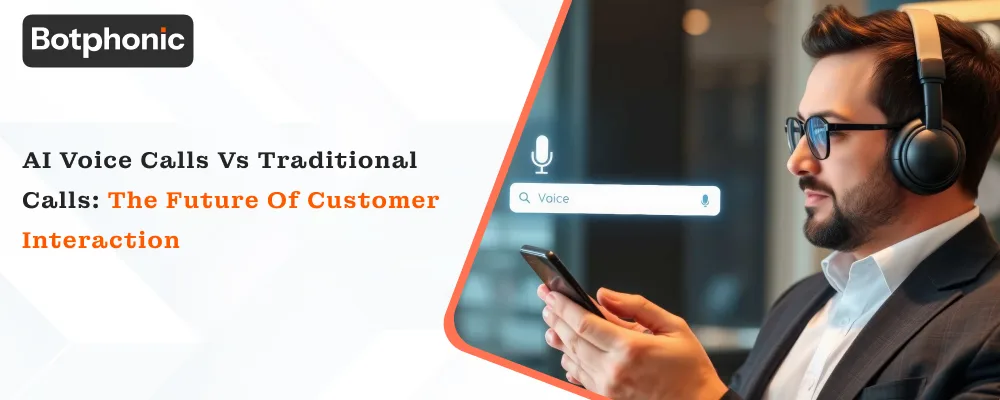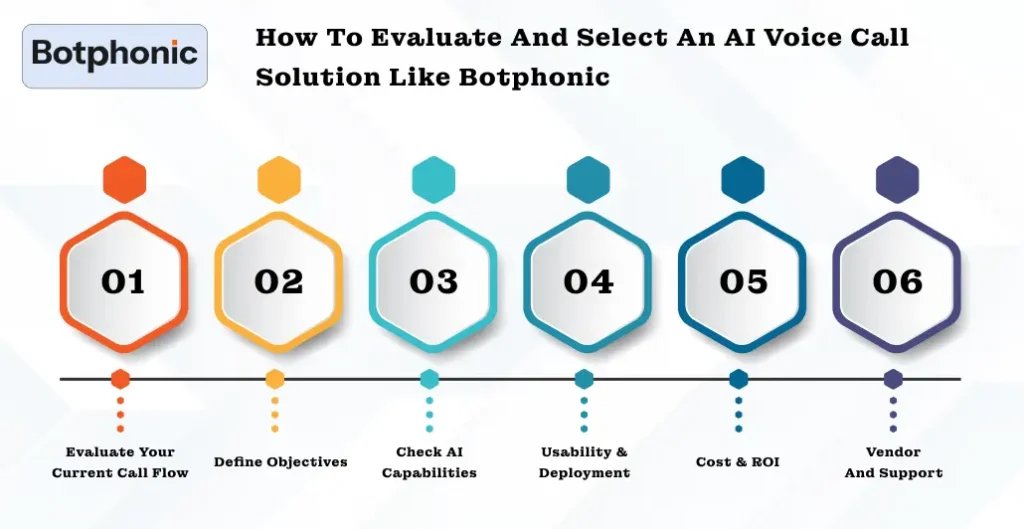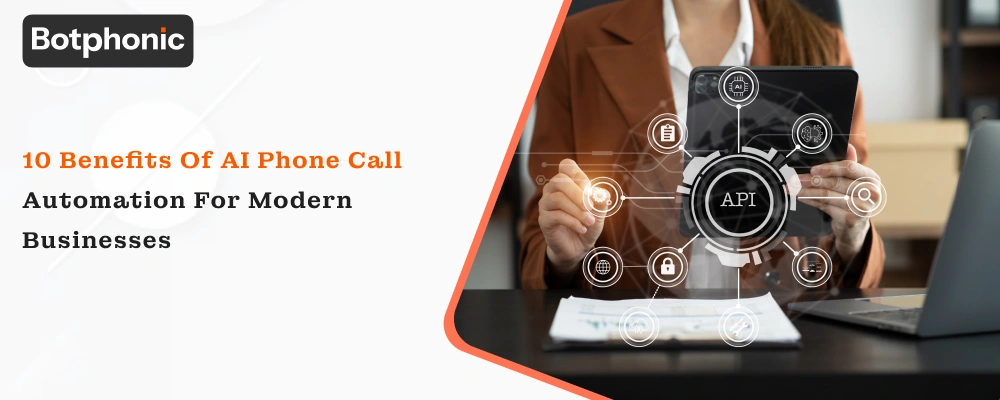
Summarize Content With:
Summary
Here, we compare AI voice calls vs. traditional calls in customer interactions. Besides that, we consider how technologies such as AI call assistants and AI booking systems change the market. We discuss the pros and cons, trends, and how your company, if you use Botphonic, can benefit from this revolution.
Key takeaways
- The concept of what AI voice calls vs. traditional calls are, and why the difference is significant.
- The efficiency, availability and cost savings that come from an AI call assistant and AI booking workflows.
- The issue with AI voice calls is that they are not as advanced or as good as traditional human conversations.
- Real advice for trying out the Botphonic service or a similar AI voice call provider in your company.
Introduction
What if your customer called your business late at night or very early in the morning, and no human agent was available? Instead of the customer listening to a message or being put on hold, the customer is assisted by a positive voice and gets the reservation made or the question answered. Comparing AI voice calls vs traditional calls, that’s the concept of the future.
This change is being driven by AI Phone Call systems’ smart automation that is capable of interacting with customers in a very natural and human-like manner without waiting for any kind of a pause.
Conventional interaction entails human agents, certain hours, menu trees and quite a lot of waiting. On the other hand, an AI call assistant can handle a large number of calls at any time of day and can even perform AI booking tasks automatically. The future of customer interaction is changing very rapidly. Let’s explore this change further.
What Are Traditional Calls?
Firstly, in comparing AI voice calls to traditional calls, one must first clarify what an AI voice call actually is. An AI voice call is a call supported by an AI call assistant: a software-driven voice system that not only detects but also comprehends the spoken language and even, in a similar way, replies.
Moreover, these are powered by an AI phone call technology that amalgamates Natural Language Processing (NLP), speech synthesis, and on-the-fly automation to make dialogues as if they were done in person and quick.
For example, if the AI is booking a service that schedules appointments, the assistant may also be doing other tasks like answering the most common queries, directing calls, or even making the outgoing follow-ups.
In a traditional setting:
- Agents are on shifts and have their set working hours.
- There may be waiting times, especially during rush hour or peak periods.
- Menu-based systems require customers to press specific numbers and follow preset paths.
- Scaling is extremely difficult: if the volume of calls doubles, you have to either increase the number of agents or increase your working hours.
The cost per call remains high due to labor, infrastructure, and training. Just to give you an example, one comparative study found that the interaction costs of traditional call centers are approximately $5 to $25. In contrast, the costs of AI-based solutions are reduced to $0.50-$5.
What Are AI Voice Calls?
The first thing we must do when contrasting AI voice calls with traditional calls is to define AI voice calls precisely. An AI voice call involves an AI call assistant: a software-driven voice system that not only recognises but also understands spoken language and even replies similarly.
In a situation like AI booking a service that schedules appointments, this assistant may handle other tasks as well, such as addressing frequently asked questions, routing calls, or even making outgoing follow-ups.
AI voice calls’ main characteristics:
- The conversation system uses Natural Language Processing (NLP) technology to understand spoken words rather than just recognising the query digits.
- It is possible to talk to the system at any time of day or night, as it does not need sleep or even lunch breaks. The clients can be served at any time.
- What is more, countless phone conversations can be carried out concurrently with the help of the so-called Loman AI technology, which eliminates the human agent bottleneck; as a result, the human side cannot be involved in these scenarios.
- Complete integration of booking systems, calendars, and CRM enables AI to automate scheduling tasks.
- Quality of an AI system over human agents and less augmentation of the human factor: agents may change, be less efficient or even make errors; AI systems are always in a steady state.
- One of the major cost-saving factors is operational efficiency: sources estimate a 30-70% reduction in operational costs, or even more, when moving from human call centres to AI voice solutions.
Key Differences: AI Voice Calls vs Traditional Calls

When comparing AI voice calls to traditional calls, the difference is more evident if you analyse the specific aspects. First, there is a table summarising the main differences, followed by the detailed commentary.
| Feature | Traditional Calls | AI Voice Calls |
| Availability | Business hours, human agents only | 24/7, unlimited simultaneous calls |
| Wait Time | Longer during peaks | Very low–near instant response |
| Cost per Interaction | Higher (labour, infrastructure, training) | Lower (automation, fewer agents) |
| Scalability | Hard, needs more human agents | Easier, system scales dynamically |
| Consistency | Variable (agent skill, fatigue) | Uniform performance |
| Integration | Often limited | Seamless with CRM, calendar, and booking |
| Personalisation | High when handled by a good agent | Moderate to high, improving fast |
Now we can talk about each of these points in detail.
1. Availability
Non-digital emergency systems rely heavily on human staff. Thus, for shift coverage from 9 am to 5 pm, calls left outside this time period are dropped. AI service vs traditional calls, to be sure, AI is always there.
2. Wait Time
In the face of a large influx of requests, people aren’t able to solve problems efficiently. Some data indicates that the use of AI voice technology drastically shortens waiting time, to the point that one study found AI call agents’ response time was less than 5 seconds, while humans took 4.5 minutes.
3. Cost per Interaction
An AI vs humans cost comparison revealed that implementing an AI solution costs $0.50-$5 per transaction, while human-intervention-based centres cost $5- $25 per transaction. The difference between the two values is enormous.
4. Scalability
More human agents mean procedures such as recruiting and training new staff members and buying new equipment. If you select AI voice calls technology as your business partner, you just need to install the new software version, and the capacity will increase.
5. Consistency
AI systems implement the established schema regardless of the number of iterations. On the other hand, human agents may differ in their manner of speech, correctness, and speed. So, in the competition between AI voice calls and traditional calls, AI wins at this point.
6. Integration
Usually, AI Phone Call Technology can interact with calendars, booking systems, CRMs, and other systems. For instance, AI booking is becoming more and more automated. Besides, with traditional calls, the user has to manually switch the system they are using.
7. Personalization
Many businesses have reported that with the implementation of AI voice calls, they are able to offer a personalized experience to each customer. Even though with the traditional calling system, it was easier to offer a personalized experience, AI call assistants are highly improving and adapting to it.
Benefits of AI Voice Calls Over Traditional Calls

When comparing AI voice calls vs traditional calls, one of the first things that comes to one’s mind is the advantages of AI voice calls. We explain these advantages in detail here.
1. Cost Savings
As the main point was, the use of AI voice calls leads to a significant reduction in the cost per interaction. The fewer human agents needed, the lower the infrastructure overhead, and the better the scalability, the more money you save. For instance, operational cost research demonstrates that AI-driven call centre solutions cut expenses by 30-70% when compared to traditional call centres.
2. Better Availability and Scalability
AI voice systems are free from time constraints, and they can also handle multiple voice communications at the same time. Hence, there are no unresponded calls and no long queue during rush hour. The companies that serve customers worldwide or have customers coming to them during their non-business hours can take all the benefits from there.
3. Faster Response Times
Time spent waiting for one’s turn to be heard is reduced significantly when AI voice calling is used. The customer is less likely to be put on hold and therefore, he is more satisfied and achieves a faster solution to his request. For instance, some systems demonstrate that the response time is less than 5 seconds, while human queues require several minutes.
4. Consistent Service Quality
AI voice calling systems diminish the chances of human errors that result in the agents’ performance due to their exhaustion and the different stages of training they have gone through. Customers’ brand loyalty will become more stable and manageable.
5. Data & Insights
By AI systems executing every command given, a record is kept of each interaction for the purpose of creating transcripts, as well as collecting statistics for the intent-recognition module. The data realisation is a must for the companies, losing no time in adjusting the processes, spotting the pain points, as well as improving services perpetually. Systems that rely solely on humans usually lack this depth.and
6. Automation of Routine Tasks
By the use of an AI call assistant and AI booking, everyday tasks (such as scheduling, responding to standard FAQs) can be handled by the robots. The human agents will then be less burdened with more value‐added calls.
How to Evaluate and Select an AI Voice Call Solution Like Botphonic

With AI voice calls, you might be wondering if it is a good move to make such a shift and how to evaluate the difference between them and traditional calls. The answer to your question would be to figure out how to select a platform if you were to choose one, particularly a platform such as Botphonic.
Evaluate Your Current Call Flow
- List the possible kinds of calls your business encounters: inbound/outbound calls, booking, routing, and support.
- Pinpoint those that are the most frequent and simplest (automation is perfect for them), as well as those that are the least frequent and most complicated (human workers are best for these).
- Gather the data: call volumes, average handle time, abandon rate, and cost per call.
Define Objectives
- What would you like to get from AI voice calls compared to traditional calls? Reduced expenses? Increased availability? Enhanced customer experience?
- How much of your calling traffic do you want to be handled by machines?
- What are your KPIs (e.g. waiting time to be cut by 50%, cost per call to be lowered by 40%)?
Check AI Capabilities
- Is the system capable of understanding natural conversational speech, or does it require predetermined command inputs only?
- Does it provide AI booking functionalities (such as an integrated calendar and confirmation in real-time)?
- Is it possible that the system supports multiple languages or accents?
- Integration: CRM, calendar, booking system, or any other business tools.
- Analytics and reporting: call transcripts, intent recognition statistics, and performance dashboards.
Usability & Deployment
- Is the process of installation, training, and supervision simple?
- If a human intervention is necessary, how can one get in touch with a human agent?
- What level of voice quality and user experience are provided to callers?
- How quickly can you be operational in your particular field?
Cost & ROI
- The expense of an AI system (be it a subscription or licensing) as compared to the cost of a human agent.
- Work out the cost per interaction, the scale, and the potential savings from AI voice calls vs traditional calls.
Don’t let your business lose calls from customers who reach out to you after hours. Allow an AI call assistant to take care of every inquiry, booking, and follow-up 24/7.
Request a Free DemoVendor and Support
- Analyze the vendor’s performance over time through case studies and references.
- For instance, Botphonic promotes features such as AI voice calls and booking automation. What do you think about their proposition? Is it easy? How many features are there? Is there a good customer service experience with them?
- Don’t forget about the support that needs to be there after the installation: updates, monitoring, etc.
Conclusion
This blog touched on the topic of AI voice calls vs traditional calls. We found out that, though traditional calls have certain advantages, they are becoming less feasible because of limitations in terms of cost, scalability, availability, consistency, and data insights.
What is more, AI voice calls via an AI call assistant and AI booking are on hand to provide faster, more efficient, scalable, and cost-effective customer interaction. We also looked at the advantages and disadvantages of human-led traditional calls (empathy, complexity handling). In addition, we discussed how to judge AI voice solutions, main points of putting them into effect, and the coming trends in this area.
If providing stellar customer service is your ambition, and also cutting costs and being able to compete in a world where customers demand instant replies are important to you, then the move away from traditional calls toward AI voice calls is a no-brainer. What is more, a tool like Botphonic would be of great assistance regarding this move. The future of customer interaction has already arrived. The question is, are you going to be the leader or the follower?

